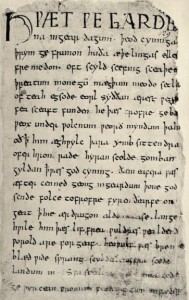Back at the start of the summer, staffer GreenDragon generously asked the publisher Houghton Mifflin Harcourt to send me a copy of Tolkien’s translation of Beowulf to review. While I started the book right away, this review has been delayed by producing Happy Hobbit and attending four conventions, along with writing two books and a script on top of daily life and work, which is a long-winded way to say that I apologize for my tardiness!
While still an undergrad, I took a course in Old English which was an introduction to the language, followed by a semester of translating Beowulf. A year isn’t enough time to master a dead language, and I was attempting to master two at once, for I was also taking Latin at the time (an alternate nickname for me could be Hermione), so I won’t be able to go into the nitty gritty mechanics of the language like Tolkien does in his notes, but I will offer what insight my education allows!

To offer some context, I will say that Old English is the name we have given to the Anglo Saxon language, for after a strong French influence after the Norman Conquest of 1066, Old English morphed into Modern English. It is important to note, as well, that Anglo Saxon is the language of our (even if you aren’t of English descent, you’re reading this in English) conquerors, for the Nordic tribes of the Angles, Saxons, and Jutes invaded England after the withdrawal of the Roman Empire around 410 CE. They renamed the island Angle-Land. England. So while Beowulf is attributed as being the first great epic in English, it is significant that it is a story from the culture that conquered the island and that its setting is in the conquering nation’s homeland in the north, not England, even though the manuscript was recorded and found in an English monastery, hidden beneath pages of religious text. All of this would have been known to J.R.R. Tolkien at the time of his translation in the 1920s.
Firstly, I will say that my reason for taking Old English was driven by my obsession with Tolkien and The Lord of the Rings. I was first exposed to Beowulf in seventh grade when I read a version of the poem for one of my classes. Enamored with the culture and the exciting, heroic tale, it lingered in my mind in a way that few stories read for school had. In the Humanities Honors Program in college, we were exposed to the literature that laid the foundations for Western civilization and I once again read a translation of Beowulf (picturing Aragorn as Beowulf this time around, of course) and while in my proceeding English courses I avoided the works I had already read, Beowulf was the one text I would read every time I was asked. As such, I have been exposed to three or four translations, including my own.



